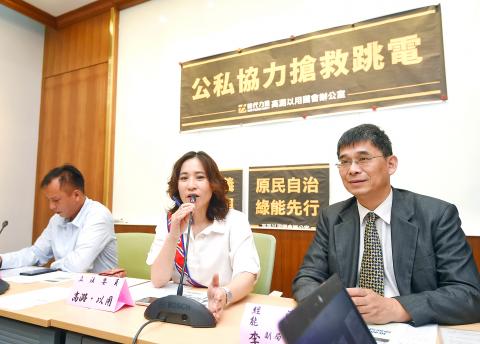A pilot program by the Bureau of Energy to subsidize civic groups’ “clean energy” generating facilities in the nation’s remote areas could help build a new energy model in Taiwan, New Power Party Legislator Kawlo Iyun Pacidal said yesterday.
Kawlo in September last year urged Premier William Lai (賴清德) to balance the needs for clean energy and energy justice during a question-and-answer session at the Legislative Yuan.
In response, the bureau on May 20 set down guidelines for subsidizing the construction of clean energy generating facilities in remote areas by civic groups.

Photo: Fang Pin-chao, Taipei Times
“The program will allow residents in remote areas, especially Aborigines, to lead the development of clean energy generating facilities. This will not only help promote energy democracy, but also better ensure that those areas have sufficient energy,” said Kawlo, who is Amis.
Considering that the nation is highly dependent on Taiwan Power Co (Taipower) for energy, the project would also improve the stability of the nation’s energy supply, she said.
Many Aboriginal communities in remote areas have the natural resources to develop solar, hydroelectric or geothermal power plants, but building those facilities would require collaboration, bureau Deputy Director-General Lee Chun-li (李君禮) said.
“The bureau used to focus on building power supply systems with Taipower in remote areas, but now we hope to encourage residents in those areas to lead such projects,” he said.
Such facilities could provide backup power to local communities when Taipower facilities are damaged by natural disasters, Lee added.
“If they have any surplus energy, communities can also profit from that by selling it to Taipower,” he said.
The bureau is to accept 10 proposals to build clean energy generating facilities in remote areas and provide a subsidy of up to NT$2 million (US$66,912) to each project to cover expenses in the initial assessment stage.
“Civic groups only need to have a rough idea of what kind of facility they would like to build, and the government would help pay the expenses needed to hire professionals for further investigation and assessments,” Li said.
In addition, the government would subsidize up to half of the construction expenses — with a cap of NT$10 billion — for each of the five cases that have passed initial reviews.
Aboriginal groups would have higher priority than other groups, the bureau said, adding that the deadline for applications is Aug. 31.
“We hope to learn from this process and are ready to make adjustments if anything needs to be changed,” Lee said.
The program requires the government to inform Aborigines and obtain their consent before building power generating facilities in their communities, Kawlo said, adding: “Community residents can be masters of their own fate and lead local energy plans.”
Hopefully, this program will soon create the first energy plant jointly built by civic groups and the government, she said.

US climber Alex Honnold is to attempt to scale Taipei 101 without a rope and harness in a live Netflix special on Jan. 24, the streaming platform announced on Wednesday. Accounting for the time difference, the two-hour broadcast of Honnold’s climb, called Skyscraper Live, is to air on Jan. 23 in the US, Netflix said in a statement. Honnold, 40, was the first person ever to free solo climb the 900m El Capitan rock formation in Yosemite National Park — a feat that was recorded and later made into the 2018 documentary film Free Solo. Netflix previewed Skyscraper Live in October, after videos

Starting on Jan. 1, YouBike riders must have insurance to use the service, and a six-month trial of NT$5 coupons under certain conditions would be implemented to balance bike shortages, a joint statement from transportation departments across Taipei, New Taipei City and Taoyuan announced yesterday. The rental bike system operator said that coupons would be offered to riders to rent bikes from full stations, for riders who take out an electric-assisted bike from a full station, and for riders who return a bike to an empty station. All riders with YouBike accounts are automatically eligible for the program, and each membership account

A classified Pentagon-produced, multiyear assessment — the Overmatch brief — highlighted unreported Chinese capabilities to destroy US military assets and identified US supply chain choke points, painting a disturbing picture of waning US military might, a New York Times editorial published on Monday said. US Secretary of Defense Pete Hegseth’s comments in November last year that “we lose every time” in Pentagon-conducted war games pitting the US against China further highlighted the uncertainty about the US’ capability to intervene in the event of a Chinese invasion of Taiwan. “It shows the Pentagon’s overreliance on expensive, vulnerable weapons as adversaries field cheap, technologically

NUMBERS IMBALANCE: More than 4 million Taiwanese have visited China this year, while only about half a million Chinese have visited here Beijing has yet to respond to Taiwan’s requests for negotiation over matters related to the recovery of cross-strait tourism, the Tourism Administration said yesterday. Taiwan’s tourism authority issued the statement after Chinese-language daily the China Times reported yesterday that the government’s policy of banning group tours to China does not stop Taiwanese from visiting the country. As of October, more than 4.2 million had traveled to China this year, exceeding last year. Beijing estimated the number of Taiwanese tourists in China could reach 4.5 million this year. By contrast, only 500,000 Chinese tourists are expected in Taiwan, the report said. The report